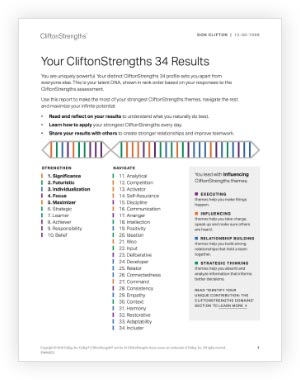Story Highlights
- Distrust of peers' decision-making is common and counterproductive
- A strengths-based workplace optimizes decision-making
- Incorporate strengths into a decision-making framework and see results
Your employees make hundreds of decisions every day. How many of those decisions promote your organization's goals?
Probably not as many as you might hope.
Gallup data show that less than a quarter (24%) of U.S. managers strongly agree that their peers make well-thought-out decisions for their organization. Worse, only 14% strongly agree they are satisfied with the speed of decision-making at their organization.
To win amid relentless workplace change, leaders must create a workplace in which smart decisions are the norm, not the exception.
If a company's managers routinely question others' decisions, the work environment will breed mistrust, diminish confidence and slow the pace of business.
Even analytics-based organizational goals will yield a bad ROI if employees don't embody leaders' strategic vision in their day-to-day actions.
To win amid relentless workplace change, leaders must create a workplace in which smart decisions are the norm, not the exception.
For example, leaders can implement cutting-edge analytics to keep up with customers' shifting needs, but to actually improve the customer experience, leaders must ensure that employees understand how to modify their behaviors -- and that they are motivated to do so every day.
Human decisions about how to apply data are what determine whether an analytics program will accelerate positive change.
Leaders who want to succeed need to help their people make better decisions faster. Fortunately, recent Gallup analytics reveal a powerful strategy for doing so: building a strengths-based workplace culture.
When employees strongly agree they get to do what they do best every day, they are four times more likely to be satisfied with the speed of decision-making in their organization. That is, an organization's decision-making process improves when employees understand their natural strengths (and those of their team members).
In fact, strengths-based workplaces see better outcomes in vital business metrics, including up to:
- 15% higher employee engagement
- 7% higher customer engagement
- 29% higher profit
- 72% lower turnover in high-turnover organizations
Here are three reasons an emphasis on employees' strengths optimizes decision-making:
1. Improved team collaboration and alignment.
Team members who know one another's strengths can better collaborate. In fact, Gallup analytics show that strengths-based teams have higher engagement, better customer service and higher profitability. This superior collaboration can promote the speed and quality of the decisions teams make.
Further, a network of high-performing teams can boost internal alignment for more consistent decision-making throughout the company. Ultimately, leaders support predictable decision-making when they position their people to work together more effectively.
For example, an account manager whose team develops a streamlined process for resolving client questions can ask an employee with natural communication talent to share those best practices with other account teams -- and, in turn, further the company's goal for enhanced customer-centricity.
2. Heightened awareness of vulnerabilities.
All people are vulnerable to biases in their decisions. Great decision-makers are keenly aware of their limitations and the situations in which they're most vulnerable to making the wrong call.
For example, a leader may have extremely strong self-confidence that makes them prone to decisions that aren't well-thought-out. Or they may be highly competitive, leading the team to choose short-term wins over stronger long-term objectives.
Mindfulness of predisposed biases does more than inform executive-level decisions. Leaders can reduce inherent bias throughout their workplace culture by empowering employees with an honest understanding of their strengths and blind spots -- and how both influence their decisions.
3. Optimized decision-making processes.
Great decision-making starts with a consistent decision-making framework. A clear decision-making model equips leaders with a mental process to follow when they encounter situations that demand action. Further, teams with a concise decision-making model can quickly navigate problems with less confusion and an intentional focus on the matter at hand.
But having a framework is just one step. Leaders need an approach that mitigates bias -- and that positions each employee based on their strengths to expedite and improve decision-making processes.
Consider the following seven-step decision-making framework:
-
Identify the decision.
-
Gather information.
-
Identify alternatives.
-
Weigh the evidence.
-
Choose among alternatives.
-
Take action.
-
Review the decision.
With insights about each employee's strengths, leaders can leverage an individual's innate talents throughout each step of the process. For example, as leaders consider evidence, they can rely on naturally strategic employees who easily identify unseen challenges that others might overlook. And when it's time to take action, leaders can task individuals with Activator to ensure the work gets done.
"Organizations are decision factories."
In an increasingly competitive marketplace, the quality of your company's decision-making can determine whether it flourishes or fails.
Here's how Daniel Kahneman, Gallup senior scientist emeritus, Nobel Prize-winning psychologist and widely regarded authority on decision-making, once put it, "Organizations are decision factories."
No leader can assess every decision made in their organization to ensure it's the right one. But they can implement proven strategies that lead to increased confidence in the quality and speed of those decisions.
Increase confidence in your organization's decision-making:
- Discover how your team works best with CliftonStrengths.
- Read the 2015 Strengths Meta-Analysis of Gallup's scientifically validated approach to strengths.
- Implement a sustainable strategy to continually develop strengths at your organization.






